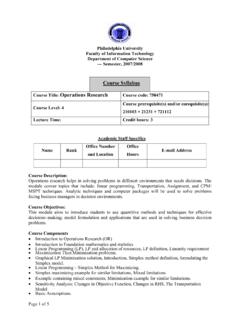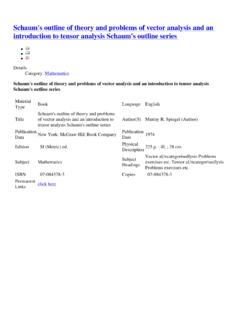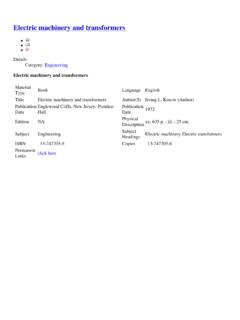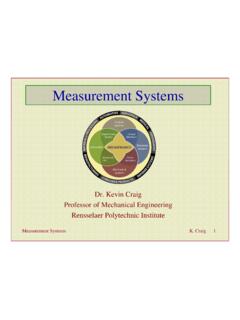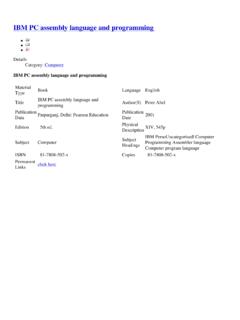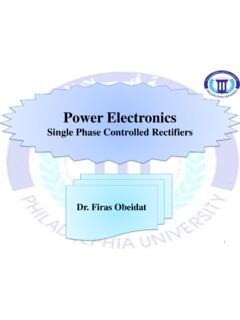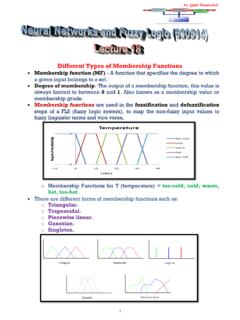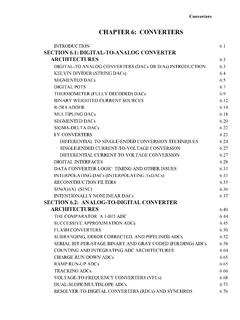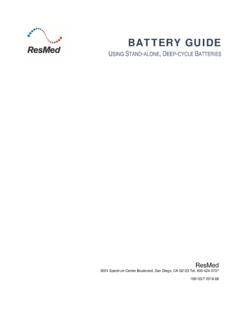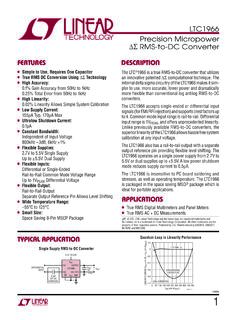Transcription of Power Electronics Lecture No. 14 Dr. Mohammed Tawfeeq ...
1 Power Electronics Lecture No. 14 Dr. Mohammed Tawfeeq Lazim Al-Zuhairi 1 14. dc to ac converters Single-phase inverters: Single-phase half-bridge inverter This type of inverter is very simple in construction. It does not need output transformer like parallel inverter. It sometimes called center-tapped source inverter. The basic configuration of this inverter is shown in Fig Single-phase inverter half-bridge circuit. The top and bottom switch has to be complementary i. e. If the top switch is closed (ON), the bottom must be off, and vice-versa.
2 The output voltage waveform is a square wave as shown in Square wave output Voltage waveform Power Electronics Lecture No. 14 Dr. Mohammed Tawfeeq Lazim Al-Zuhairi 2 In practice, a dead time between ON and OFF (td) for Q1 & Q2 is required to avoid short circuit or shoot-through faults. This leads to produce quasi-square wave output voltage ( ). Performance of Half-Bridge Inverter with Resistive - Inductive loads: If the load is resistive, the output current waveform will be a copy of the voltage waveform as shown in (a).
3 The output voltage is a square (or quasi-square) wave. However with an inductive load (b), the load current i is delayed although the output voltage wave is still a square. The current will grow exponentially during the positive half-cycle from In to Ip according to the following equation: - Through D1 [load returning Power to the upper half of the source]. - Through Q1 [load absorbing Power from the upper half of the source] until t = , whereby i = Ip. Power Electronics Lecture No. 14 Dr. Mohammed Tawfeeq Lazim Al-Zuhairi 3 (a) Operation with Resistive Load (b) Operation with Inductive Load Output voltage and current for single-phase half-bridge Negative half cycle starts by conduction of Q2.
4 Current start its change from Ip to zero through D2 and then to In through Q2, according to: ( ). RMS value of the Load voltage: = = = Power Electronics Lecture No. 14 Dr. Mohammed Tawfeeq Lazim Al-Zuhairi 4 Load voltage can be expressed in terms of harmonics by Fourier series as: = , = 0 for n=2,4, Where: = 2 f0 is the frequency of the output voltage in (rad/sec) . The fundamental component of the load voltage had a peak value , and it has value For an R - L load, the instantaneous load current i can be found by dividing the instantaneous output voltage by the load impedance Z= R + jn L , or , thus i( t)= i( t) = where = If Io1 is the fundamental load current, the fundamental output Power (for n=1) is: = Note.
5 In most applications (e. g. electric motor drives) the output Power due to the fundamental current is generally the useful Power , Power Electronics Lecture No. 14 Dr. Mohammed Tawfeeq Lazim Al-Zuhairi 5 and the Power due to harmonic currents is dissipated as heat and increases the load temperature. Power Electronics Lecture No. 14 Dr. Mohammed Tawfeeq Lazim Al-Zuhairi 6 Single-phase full-bridge inverter The single-phase bridge Inverter using BJT transistors is shown in This inverter is constructed from two half bridge inverter using single DC source Vd and the load is connected between the centers of the two legs.
6 Single-phase full-bridge inverter circuit SQUARE-WAVE OUTPUT : Q1 and Q2 are triggered simultaneously and so are Q3 and Q4. Each device is made to conduct for half time of the output cycle, the load voltage waveform with the transistor base currents are shown in Fig Power Electronics Lecture No. 14 Dr. Mohammed Tawfeeq Lazim Al-Zuhairi 7 Performance with R - L load: With resistive - inductive load, the current i0 lags the square wave output voltage v0 as shown in - Triggering Q1 & Q2 connects the load to Vd.
7 For steady load condition, i0 grows exponentially through D1 D2 and then through Q1 Q2 from In to Ip according to (Vd = Ri + L ) . - Negative half cycle starts by triggering Q3 & Q4 at , and Q1 Q2 goes off when ib1 = ib2 = 0 ( base current blocking). current for single-phase full-bridge inverter. - Load voltage reverses to Vd and io will flow through D3D4 and then through Q3Q4 according to the equation (-Vd = Ri + L ). At the end of negative half cycle io = -In. Note that: t1 = Load voltage = = Vd.
8 Power Electronics Lecture No. 14 Dr. Mohammed Tawfeeq Lazim Al-Zuhairi 8 Load voltage V0(t) may be expressed as: . The peak value of the fundamental component (n=1) of the load voltage is, (maximum or peak value) The RMS value of the fundamental component is ( value). Load current and Power can be determine from And P = . where the instantaneous value of the load current io for an R-L load is The angle by which the load current lgs the load voltage is.
9 The total harmonic distortion factor is, THD = Power Electronics Lecture No. 14 Dr. Mohammed Tawfeeq Lazim Al-Zuhairi 9 When diodes D1 and D2 are conducting, the energy fed back to the source, thus they are known as feedback diodes. Power Electronics Lecture No. 14 Dr. Mohammed Tawfeeq Lazim Al-Zuhairi 10 Power Electronics Lecture No. 14 Dr. Mohammed Tawfeeq Lazim Al-Zuhairi 11 ! Inverter Output Voltage Control Many inverter applications require a means of output voltage control.
10 In most of these applications this control is usually required in order to provide stepless adjustment of the inverter output voltage. The methods of control can be group into three broad categories:- 1. Control of voltage supplies to the inverter 2. Control of voltage delivered by the inverter 3. Control of voltage within the inverter. There are a number of well-known methods of controlling the voltage supplies to an inverter or the voltage delivered by an inverter. These include the use of choppers, and phase-controlled rectifiers. The principal disadvantage of these methods is that the Power delivered by the inverter is handed twice, once by the or voltage control and once by the inverter.
